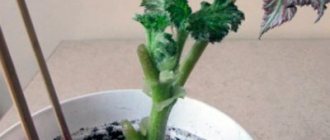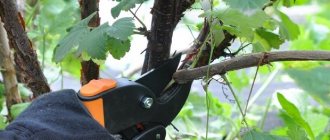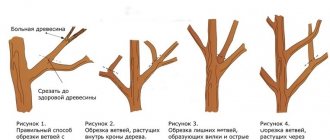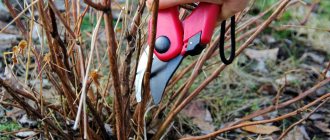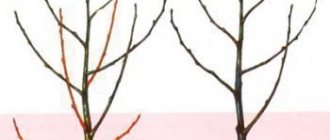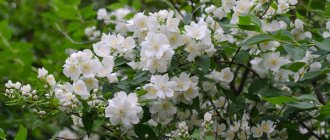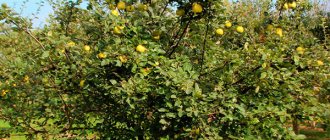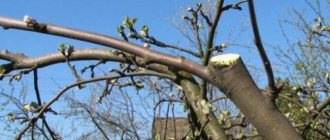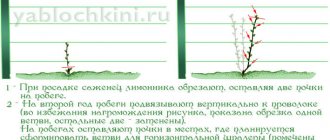Why do geraniums need a haircut?
Every spring we can see how bushes and trees are trimmed on the central streets of the city, giving them the correct shape. But few people realize that this haircut is not only decorative. Plants are pruned to improve the health and rejuvenation of the crown. The same applies to indoor specimens prone to intensive growth, such as pelargonium (geranium).
Purpose and benefits of pruning
The main purpose of pruning any plant is to thin the crown to improve air exchange, lighting and leaf nutrition. Without this event, the geranium will have a neglected and unhealthy appearance, will stop blooming, and will turn into a shapeless and unkempt bush.
What are the benefits of pruning geraniums:
- flowering period is extended;
- metabolism accelerates and its quality improves;
- more lateral branches and young shoots are formed;
- wintering becomes easier.
The flowering time of geraniums depends on the variety and occurs from early spring to late autumn, and in some varieties even in winter. In order to have a lot of inflorescences on the plant, it is necessary to prune the bush, but do it correctly and in a timely manner, according to the characteristics of the variety.
To form a beautiful bush and lush color, geraniums need regular pruning.
Autumn pruning is a more logical procedure than spring pruning. From November to February, geraniums begin their dormant period. The plant often slows down its development while continuing to feed. In this state it is very difficult to maintain a lush crown, but cutting it makes wintering much easier. Drastic pruning allows pelargonium to refresh the crown and re-form the bush.
If your pelargonium blooms all year round, then you can cut it at any time.
In winter, geraniums can be trimmed only if there are conditions for maintaining the trimmed flower; at least two lower leaves are left. After the crown of the plant has rejuvenated due to radical pruning, its bush can be formed during the winter by pinching and decorative pruning. Zonal pelargonium has the peculiarity of rapid budding and early formation of buds, so it will only be happy to be trimmed;
- ivy-leaved pelargonium can be cut in both spring and autumn. If the bush becomes excessively elongated during the winter, it is trimmed at the end of February - beginning of March;
- Flower growers cut ampelous geraniums at their own discretion; if the plant does not need pruning, then it is not touched until spring;
- the variegated species is difficult to tolerate autumn pruning; it is easier for them to go through such stress in the spring;
- mini-varieties of geraniums are not cut at all. The crown of these tiny pelargoniums is adjusted only for reasons of beauty and decorativeness of the bush;
- Royal pelargonium is trimmed “under the stump” and placed in a cool place. But such a drastic pruning is not done regularly, but only when necessary, because the plant does not develop as intensively as, for example, zonal geranium.
Photo gallery: geranium varieties
Ivy-leaved pelargonium can be cut in both spring and autumn
Mini varieties can do without pruning
The variegated variety of pelargonium tolerates spring pruning more easily.
Ampelous pelargonium can be left alone until spring Royal pelargonium is pruned to a stump
Zonal pelargonium is pruned in the fall
Video: crown formation of geraniums in winter
Crown formation
It is necessary to form the crown of geranium almost immediately after planting the cutting. The main actions to achieve this goal are pruning and pinching. If geraniums are pruned in the fall, you can prune or pinch them in the spring. What is the difference? Pinching is the removal of a plant's growing point. In its absence, the geranium throws out side shoots and turns into a small branched tree. The first pinching is done on the 8th or 10th leaf. It is held at the end of February-March. Side shoots are also pinched as they grow. There is no point in delaying spring manipulations with geraniums. The later the pinching is done, the longer the time until the flowers appear.
How to prune pelargonium in spring
Pruning geraniums in spring differs from autumn pruning. It is simpler, more gentle, but requires more attention, since the plant restarts life processes in the spring, and at this moment it is easy to harm it.
Purpose and benefits of spring haircut
Spring pruning is necessary to remove weakened and elongated stems. It promotes lush flowering, the growth of fresh green mass and is not produced as deep as the autumn one. It is worth cutting carefully, superficially, otherwise you can delay the flowering of pelargonium for a long time.
Even pruned shoots, rooted in the spring, bloom faster than the radically pruned mother bush.
During the winter, geranium becomes very elongated and often sheds its leaves.
Classic pelargonium (zonal) can turn into a tall, half-naked bush over the winter. This distinguishes it from its dwarf counterparts, who hardly stretch out during the resting period.
Winter pruning of zonal geranium will only harm it, but spring pruning will provoke a massive formation of new buds or the awakening of dormant ones.
Step-by-step instructions for spring pruning
- Haircuts begin no earlier than the end of February, but you shouldn’t wait until mid-March. The sooner you remove excess branches, the faster new buds will form.
After pruning, young shoots will quickly begin to grow
- It is necessary to shorten long, diseased and bare stems, leaving at least 3 buds on each cut shoot.
When forming a geranium bush, leave three buds per shoot. - Branches pruned in spring take root very quickly, so very often spring pruning of geranium is accompanied by its propagation through cuttings.
Cuttings after spring pruning can be used to propagate geraniums
Video: how to prune flowering geraniums correctly
Table: caring for geraniums after spring pruning
| Temperature | An increase in temperature of 3–5°C is allowed (compared to winter). |
| Lighting | Intensive, preferably south window. |
| Watering | A gradual return from moderate winter watering to normal. |
| Top dressing | Spraying with Epin solution (once a week, three times a month). |
| Air humidity | No promotion required. |
Crown formation in winter
The winter months are a dormant time for geraniums. Short daylight hours and lack of solar energy send this indoor flower into hibernation.
- does not bloom;
- does not give active growth;
- does not form new shoots.
As a rule, there is no need for pruning in winter. During this period, you need to monitor the condition of the geranium. Particular attention should be paid to shoots that were pruned in the fall. If the cut areas begin to turn black or rot, then the affected area should be cut off.
If the need arises, the time for the main pruning can be postponed to the second half of February. However, if possible, it is better to postpone this procedure until March.
Before the onset of winter, it is recommended to tame all shoots by at least 1/3. This allows you to activate kidneys that are in an inactive state. This procedure has a beneficial effect on the formation of geraniums.
How to form a fluffy pelargonium bush
Pinching the crown of a plant stops the growth of the main stem, but does not stop its development completely. This is a great opportunity, by limiting the vertical growth of the flower, to get a luxurious crown.
The essence of pinching
The essence of pinching geraniums is to simply remove the growing point, that is, the top of the plant. The flower loses its ability to form shoots from the center of the bush and begins to produce lateral branches. Thus, the plant becomes more magnificent, bushier, and takes on a spherical shape.
Young plants are formed using the pinching method, and the most favorable time for this is late winter and early spring.
Pinching the top of a royal geranium stops the growth of the central shoot and stimulates the development of lateral shoots.
In the case when the geranium was grown from a cutting, pinching is done after the ninth or tenth leaf, and if the pelargonium grew from a seed, after the seventh. Leave those shoots that grow from the axil of the upper pair of leaves.
Pinching leads to active growth of young shoots
Mini-geraniums or very young, just rooted plants can be pinched at the initial stage of growth if you want to get a short and round bush.
If you pinch a geranium at a young age, it will turn into a small spherical bush
You need to pinch the plant with clean hands so as not to cause an infection or ruin the bush. To treat the shoot, you can use ash or talc.
Video: how to properly pinch geraniums in spring
Pruning: necessary or useless procedure?
Of course, geraniums do not need to be pruned. But will the plant turn into a beautiful flowering bush? Most likely no. Geraniums have a tendency to stretch their stems. The elongated stem does not become covered with leaves and does not throw out inflorescences. The plant will grow, but there will be nothing to please the eye. Some gardeners suggest not to bother with old plants, pruning and pinching them. They consider the best option to trim the old bush in the fall, throw away the root, and root the cuttings to get a young plant.
Without pruning, geraniums stretch upward and become bare and ugly.
If you save old faded geraniums, then it is important not to forget that pruning is the greatest test for the plant. Therefore, it is better to carry it out when the daylight hours increase, that is, at the end of winter or beginning of spring. Autumn pruning is less tolerated by pelargonium and the plant may not have enough strength to recover.
Step-by-step instructions and pruning diagram for lush flowering
Let's look at how to properly prune homemade geraniums so that they bloom profusely and are fluffy. The splendor of geranium flowering directly depends on the quality of pruning. The plant must be trimmed as follows:
To avoid thickening and the formation of new shoots, you need to use a prepared tool to cut the stem above the leaf node facing the outer part of the bush.
- In order not to leave the cutting bare, the shoot is cut off above the leaf.
- Stems that grow inside the bush should be trimmed.
- In order for the plant to use energy to form the main stems, you need to pinch the shoots from the root.
- It is necessary to remove intertwined branches, as well as diseased and bare shoots.
- The stems are cut at the level of 4-5 leaf nodes.
- The main shoots should be cut back to a third of their length.
- To prevent the possibility of infection of the flower, treat the cut areas with activated or charcoal or cinnamon powder.
- After pruning, it is necessary to feed the geranium with nitrogen-containing fertilizer.
Pinching also helps to achieve lush flowering . After this procedure, the bush becomes wider and denser.
We recommend watching a video about the correct pruning of geraniums for lush flowering:
Read more about how to care for geraniums so they bloom here.
